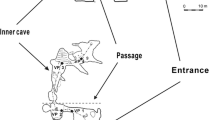Abstract
On the basis of air temperature (T) monitoring, basic statistical and time series analysis was employed to evaluate thermal states of cave atmosphere variations. Long-term, seasonal and event comparative analysis as well as spectral and cross-correlation analysis was conducted. The results show the relative stability of air T in the isolated part of the cave, whereas variable air T was observed in the parts close to entrances and the surface. The distinctive seasonality in this part of the cave demonstrates that air convection is a driving force for the heat exchange between the cave and the surrounding environment. External air T and heat conducted through the rock walls are also an important factor influencing the cave climate, while heat released by the ice deposit and by water infiltrating through the cave ceiling has a negligible effect. Occasional irregular variations in daily patterns are caused by human impact.










Similar content being viewed by others
References
ARSO (2012) The archive of the environmental Agency of the Republic of Slovenia, Ljubljana. http://meteo.arso.gov.si. Accessed 3 Oct 2012
Atkinson TC, Smart PL, Wigley TML (1983) Climate and natural radon levels in Castleguard Cave, Columbia Icefields, Alberta, Canada. Arctic Alpine Res 15(4):487–502. doi:10.2307/1551235
Badino G (2010) Underground meteorology—“What’s the weather underground?”. Acta Carsologica 39(3):427–448
Bourges F, Genthon P, Mangin A, D'Hulst D (2006) Microclimates of l'aven d'Orgnac and other French limestone caves (Chauvet, Esparros, Marsoulas). Int J Climatol 26(12):1651–1670. doi:10.1002/joc.1327
Cigna AA (2002) Modern trend in cave monitoring. Acta Carsologica 31(1):35–54
De Freitas CR (2010) The role and importance of cave microclimate in the sustainable use and management of show caves. Acta Carsologica 39(3):477–489
De Freitas CR, Littlejohn RN (1987) Cave climate: assessment of heat and moisture exchange. J Climatol 7:553–569. doi:10.1002/joc.3370070604
Domínguez-Villar D, Fairchild IJ, Carrasco RM, Pedraza J, Baker A (2010) The effect of visitors in a touristic cave and the resulting constraints on natural thermal conditions for palaeoclimate studies (Eagle cave, central Spain). Acta Carsologica 39(3):491–502
Gillieson D (1996) Caves: processes, development and management. Blackwell, Cambridge
Gospodarič R (1987) Speleogeological data about Taborska jama and its vicinity. Acta Carsologica 16(1):19–34
Hoyos M, Soler V, Cañaveras JC, Sanchez-Moral S, Sanz-Rubio E (1998) Microclimatic characterization of a karstic cave: human impact on microenvironmental parameters of a prehistoric rock art cave (Candamo Cave, northern Spain). Environ Geol 33:231–242. doi:10.1007/s002540050242
Kogovšek J (1990) Značilnosti pretakanja padavin skozi strop Taborske jame. Acta Carsologica 19:141–156
Kranjc A, Opara B (2002) Temperature monitoring in Škocjanske jame caves. Acta Carsologica 31(1):85–96
Lario J, Soler V (2010) Microclimate monitoring of Pozalagua cave (Vizcaya, Spain): application to management and protection of show caves. J Cave Karst Stud 72(3):169–180. doi:10.4311/jcks2009lsc0093
Lismonde B (2002) Climatologie du monde souterrain: Vents des ténèbres. Edition du Comité Départemental de Spéléologie de Isère, Tome, 1
Luetscher M, Jeannin PY (2004a) The role of winter air circulation for the presence of subsurface ice accumulations: an example from Monlesi ice cave (Switzerland). Theor Appl Karstol 17:19–25
Luetscher M, Jeannin PY (2004b) Temperature distribution in karst systems: the role of air and water fluxes. Terra Nova 16:344–350. doi:10.1111/j.1365-3121.2004.00572.x
Milanolo S, Gabrovšek F (2009) Analysis of carbon dioxide variations in the atmosphere of Srednja Bijambarska Cave, Bosnia and Herzegovina. Bound Lay Meteorol 131:479–493
Moore GW, Sullivan GN (1978) Speleology: the study of caves. Zephyrus, Teaneck, 150 p
Perrier F, Morat P, Le Mouel JL (2001) Pressure induced temperature variations in an underground quarry. Earth Planet Sci Lett 191:145–156. doi:10.1016/S0012-821X(01)00411-3
Perşoiu A, Onac BP, Perşoiu I (2011) The interplay between air temperature and ice mass balance changes in Scărişoara Ice Cave, Romania. Acta Carsologica 40(3):445–456
Pflitsch A, Piasecki J (2003) Detection of an airflow system in Niedzwiedzia (Bear) Cave, Kletno, Poland. J Cave Karst Stud 64(3):160–173
Piasecki J, Sawinski T, Zelinka J (2005) Spatial differentiation of the air temperature in the entrance collapse of Dobšinská ice cave as contribution to the recognition of the problem of air exchange between cave and the surface. Acta Carsologica Slovaca 43:81–96
Pulido-Bosch A, Martín-Rosales W, López-Chicano M, RodríguezNavarro CM, Vallejos A (1997) Human impact in a tourist karstic cave (Aracena, Spain). Environ Geol 31(3–4):142–149. doi:10.1007/s002540050173
Šebela S, Turk J (2011) Local characteristics of Postojna Cave climate, air temperature, and pressure monitoring. Theor Appl Climatol 105(3–4):371–386. doi:10.1007/s00704-011-0397-9
Šebela S, Prelovšek M, Turk J (2012) Impact of peak period visits on the Postojna Cave (Slovenia) microclimate. Theor Appl Climatol 111(1–2):51–64. doi:10.1007/s00704-012-0644-8
Smithson PA (1991) Inter-relationships between cave and outside air temperatures. Theor Appl Climatol 44:65–73. doi:10.1007/BF00865553
Wigley TML, Brown MC (1976) The physics of caves. In: The science of speleology. Academic, New York, pp 329–358
Acknowledgments
The authors are grateful for the valuable review comments and suggestions from the anonymous reviewers, the Editor-in-Chief Hartmut Graßl and to Wayne Tuttle for language review.
Author information
Authors and Affiliations
Corresponding author
Rights and permissions
About this article
Cite this article
Ravbar, N., Kosutnik, J. Variations of karst underground air temperature induced by various factors (Cave of Županova jama, Central Slovenia). Theor Appl Climatol 116, 327–341 (2014). https://doi.org/10.1007/s00704-013-0955-4
Received:
Accepted:
Published:
Issue Date:
DOI: https://doi.org/10.1007/s00704-013-0955-4




